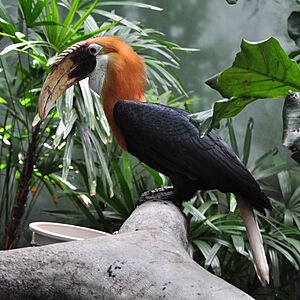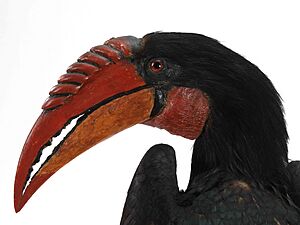Blyth's hornbill facts for kids
Quick facts for kids Blyth's hornbill |
|
|---|---|
 |
|
| Adult male at Lincoln Park Zoo | |
 |
|
| Female | |
| Conservation status | |
| Scientific classification | |
| Genus: |
Rhyticeros
|
| Species: |
plicatus
|
| Subspecies | |
|
6 subspecies, see text |
|
| Synonyms | |
|
Aceros plicatus (Forster, 1781) |
|
The Blyth's hornbill (Rhyticeros plicatus) is a very large bird. It is also called the Papuan hornbill. This amazing bird lives high in the trees of rainforests in areas like Wallacea and Melanesia. In some places, like Tok Pisin, people call it kokomo.
This hornbill was named after Edward Blyth, an English zoologist. He was a museum curator who studied animals.
Contents
What Does the Blyth's Hornbill Look Like?
The Blyth's hornbill can grow up to about 91 centimeters (3 feet) long. That's pretty big! The adult male is mostly black. It has a golden or orange-colored head. Its throat and tail are white. The male's eyes are reddish-brown, and the skin around its eyes is pale blue.
The female is a bit smaller than the male. She is also mostly black with a white throat and tail. Both male and female hornbills have a very large, horn-colored beak. They also have a special growth on top of their beak called a casque. Young birds look similar to the male. Adult birds can have up to eight folds on their casque, which shows how old they are. Young birds do not have these folds.
When this hornbill flies, its wings make a loud, rushing sound. Some people say it sounds like steam escaping from a train! It also makes a variety of deep, rumbling or laughing calls that can be heard far away.
Where Do Blyth's Hornbills Live?
The Papuan hornbill lives in lowland forests. You can find them from sea level up to about 1,200–1,500 meters (about 4,000–5,000 feet) high. They live in the Moluccas, New Guinea, the Bismarck Archipelago, and as far east as the Solomon Islands. This is the only type of hornbill that lives in New Guinea. It is also one of the biggest flying birds in that area.
What Do They Eat?
Blyth's hornbills mainly eat fruits, especially figs. Sometimes, they also eat insects and other small animals.
How Do They Nest?
Papuan hornbills build their nests in large hollows inside tall rainforest trees. These nests are usually very high up, from about 18 meters (60 feet) to 30 meters (100 feet) above the ground. When the female is ready to lay eggs, she seals herself inside the tree hollow. She uses a mix of fruit pulp and rotten wood to close the entrance. She leaves only a small opening. The male hornbill then feeds her through this small opening while she incubates the eggs and cares for the chicks. They usually lay about two eggs.
Are Blyth's Hornbills Endangered?
The Papuan hornbill is still found in many places. Because of this, it is listed as "least concern" on the IUCN Red List of Threatened Species. This means it is not currently considered an endangered species. However, some local groups hunt these birds. They use the feathers for headdresses and the beak for decorations or tools. This hunting can make the hornbill rarer in some parts of New Guinea. Even with some hunting, the species has survived for thousands of years. As long as their forest homes are protected, hunting alone is not likely to be a major threat.
Subspecies
There are different types of Blyth's hornbills, called subspecies, found in various locations:
- R. p. plicatus – Found in the South Moluccas
- R. p. ruficollis – Found in the North Moluccas and West Papua, extending to parts of Papua New Guinea
- R. p. jungei – Found in Eastern New Guinea
- R. p. dampieri – Found in the Bismarck Archipelago
- R. p. harterti – Found on Bougainville and Buka Islands
- R. p. mendanae – Found in the Solomon Islands



